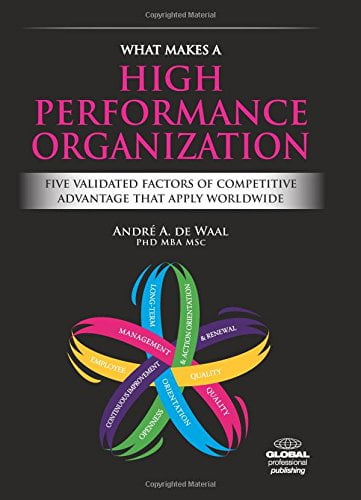What Makes a High Performance Organization: Five Factors of Competitive Advantage that Apply Worldwide

Declining consumer confidence, poor bottom-line results, the prospect of economy ups-and-downs and the continuing financial crisis in Europe have combined to prompt many organizations to attempt drastic actions. In his latest book "What Makes A High Performance Organization: Five Validated Factors o...
Declining consumer confidence, poor bottom-line results, the prospect of economy ups-and-downs and the continuing financial crisis in Europe have combined to prompt many organizations to attempt drastic actions. In his latest book “What Makes A High Performance Organization: Five Validated Factors of Competitive Advantage that Apply Worldwide” Dr. André de Waal, Academic Director of the HPO Center and Associate Professor of High Performance Organizations at the Maastricht School of Management, reveals the ‘holy grail’ of highly successful organizations. After years of global research into the success factors of High Performance Organizations (HPOs), his new book reports his validated findings and offers an HPO Framework currently in use by over 2,000 organizations worldwide.
“This book is meant for anyone interested in improving organizations, using a scientifically validated framework instead of depending on the latest management fad.”
After introducing in Chapter 1 the HPO and the HPO Framework and their accompanying benefits, Chapter 2 concentrates on the research done by the HPO Center to develop the HPO Framework for practitioners to improve organizational performance. Five factors of high performance – the HPO factors – are introduced as well as several factors that during the research turned out to be of lesser importance than always thought for becoming an HPO. In this chapter the question is also raised, and answered, whether the five HPO factors will remain the same through time and thus whether they will still be relevant for managers in the future. Chapter 2 concludes with the practical application of the framework by introducing the HPO Diagnosis. The working of the diagnosis is illustrated by the experiences at two case companies. Chapters 3 through 7 go in more detail into the five HPO factors. They describe the underlying characteristics of high performance, and ideas to get started – originating from the HPO research and other recent organizational studies – with improving the characteristics are given. Chapter 8 gives the steps which need to be taken to make the transition to an HPO are described. Finally, in Chapter 9 the added value of the HPO Framework is discussed, based on the experiences of organizations and researchers while working with the framework.
This book includes many real-life examples from organizational branches, e.g., Finance, Retail, Industry, ICT, High Education and Government, illustrating the workings of the HPO Framework at organizations in Western and emerging markets. Also included are many interviews with HPO leaders, e.g., Microsoft, SABMiller, Unilever, KLM Royal Dutch Airlines, Umpqua Bank, Tata Steel, Svenska Handelsbanken and HP.
“This pioneering work of Dr. de Waal is a must read for people interested in this subject.”
Prof. Manfred F.R. Kets de Vries, Professor at INSEAD and one of the world’s most influential thinkers

